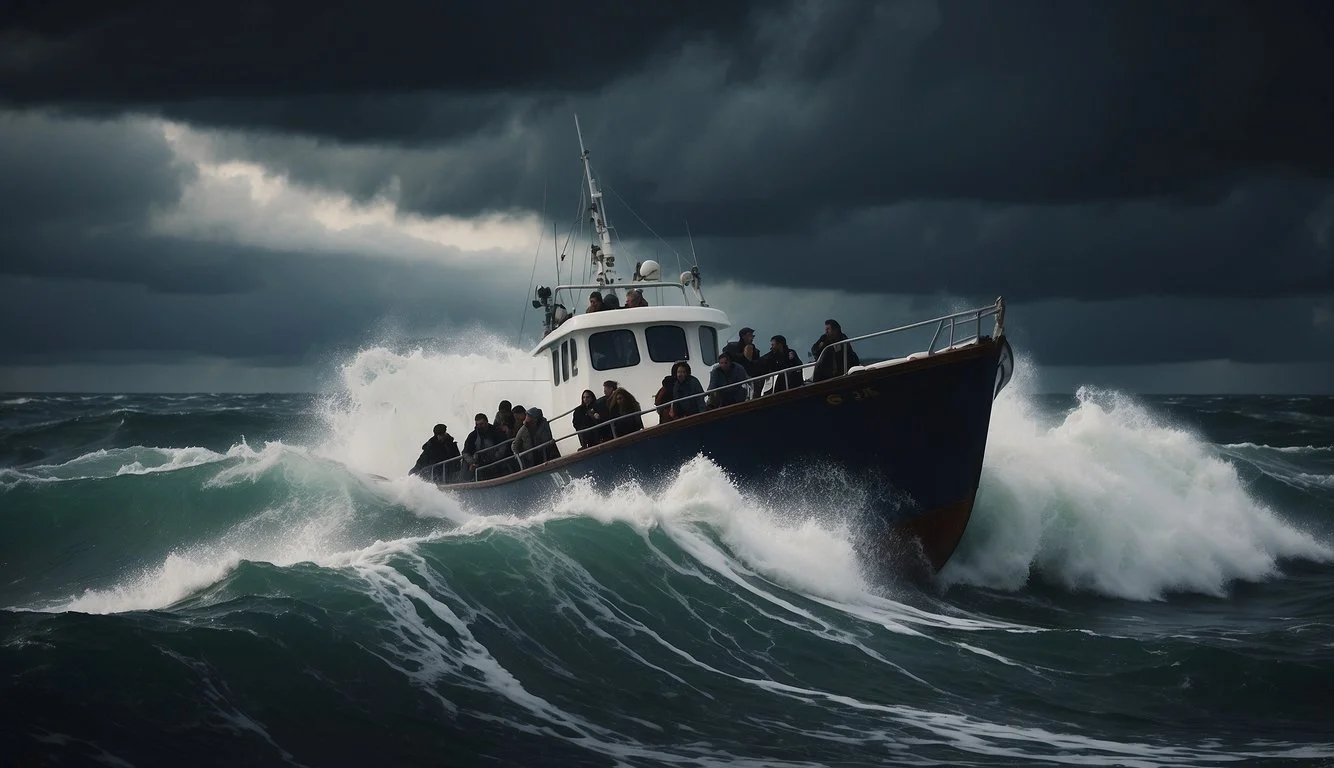Documentary Review: Flee (2021)
A Powerful Tale of Resilience
In the world of animated documentaries, "Flee" stands out as a poignant and visually compelling narrative. Directed by Jonas Poher Rasmussen, this film effectively combines recorded interviews with striking animation to tell the harrowing story of an Afghan refugee's journey. "Flee" uniquely captures the delicate balance between belonging and wandering, offering a vivid and emotionally resonant experience.
The film follows the life of Amin Nawabi, whose voice recounts his flight from Kabul to Copenhagen. Rasmussen's approach is both intimate and expansive, using minimalist animation to convey complex emotions and events. This mix of techniques not only enriches the storytelling but also provides a fresh perspective on the refugee experience.
"Flee" has garnered widespread critical acclaim, with reviews from sources like Roger Ebert and Variety highlighting its sophistication and depth. As one of 2021's best films, it offers an extraordinary blend of personal narrative and broader social issues.
Background on 'Flee'
'Flee' is a 2021 documentary that intertwines recorded interviews and animation to tell the harrowing journey of an Afghan refugee. Directed by Jonas Poher Rasmussen, it’s a visually compelling and emotionally resonant film.
Production History
'Flee' is directed by Danish filmmaker Jonas Poher Rasmussen. The documentary premiered at the Sundance Film Festival in January 2021 and gained instant recognition. It was produced by Final Cut for Real and co-produced with other European organizations. The post-production was handled by major Danish companies, ensuring a polished final product.
The film had a unique production process, blending traditional documentary practices with innovative animation techniques. It was partly funded by various international film grants and institutions, demonstrating widespread support and interest in telling the refugee story authentically.
Plot Synopsis
The documentary recounts the true story of Amin Nawabi, who fled Afghanistan as a child in the 1980s. The narrative unfolds as Amin, now an adult living in Denmark, reveals the details of his past to Rasmussen, his close friend. They discuss his escape from the Mujahideen, the harrowing journey through Russia, and his eventual settlement in Denmark.
Amin's story is both deeply personal and universally resonant, highlighting the complexities of the refugee experience. Through his interviews, Amin sheds light on the emotional and physical toll of migration, as well as the struggles of maintaining one's identity amidst such turbulence.
Cinematic Techniques
'Flee' employs a distinctive animation style that effectively captures Amin’s memories and emotions. The animation is sparse yet evocative, combining simplicity with an expressive color palette to convey the mood and tone of Amin’s experiences. This choice allows the documentary to visualize events that weren’t captured on camera, bridging gaps in storytelling.
In addition to animation, the film uses archival footage and photographs to provide historical context. The integration of different mediums creates a dynamic viewing experience. Rasmussen’s narrative technique, combining conversational interviews with visual storytelling, forms a compelling framework that keeps the audience engaged while deepening their connection to Amin's journey.
Themes and Motifs
"Flee" (2021) skillfully intertwines personal narrative and broader social issues, focusing on asylum, identity, and the innovative use of animation to convey its story. These themes are explored with a distinct, clear voice that highlights the emotional depth and complex experiences of the subject.
Exploration of Asylum
"Flee" delves into the harrowing journey of an Afghan refugee seeking asylum. The film follows Amin's escape from Kabul, navigating dangerous terrains and hostile environments, showcasing the perilous reality faced by many refugees.
The theme of asylum is underscored by the constant threat of deportation and the uncertainties of a new life in a foreign land. The film emphasizes the emotional toll and resilience required in the face of such adversity, providing a sobering look at the global refugee crisis.
Identity and Self-Perception
The documentary dives into Amin's struggles with identity and self-perception, particularly as a gay man from a conservative background. It explores his internal conflict and the cultural and societal pressures that shape his self-view.
Through intimate interviews and reflective moments, Amin’s journey of self-acceptance is revealed. This theme is crucial as it touches on broader issues of LGBTQ+ identity within the refugee experience. His narrative illustrates the intersection of personal and political challenges faced by those with marginalized identities.
Animation as a Storytelling Medium
Animation in "Flee" serves as a powerful storytelling medium, adding depth to Amin's story. It allows for the visual representation of memories and emotions that might be difficult to convey through traditional documentary techniques.
The animation provides a layer of abstraction that can make the harsh realities more accessible and emotionally resonant. This method also ensures anonymity, protecting Amin’s identity while still vividly portraying his experiences. The stylistic choice enriches the narrative, making it both visually compelling and deeply personal.
Director's Perspective
Jonas Poher Rasmussen brings a deeply personal touch to Flee, influenced by a blend of cinematic styles and compassionate storytelling. His direction shines through in the film's evocative animation and emotionally rich narrative.
Jonas Poher Rasmussen's Vision
Jonas Poher Rasmussen envisioned Flee as a way to tell the harrowing yet hopeful story of an Afghan refugee. His approach uniquely combines animation with real interviews, providing both an artistic and authentic representation of the protagonist's experiences. This choice allows for a fluid narrative that captures the emotional landscapes and physical journeys of refugees.
Rasmussen's direction aims to create a personal connection between the audience and the story. His use of visual sparse yet emotionally vibrant animation emphasizes the subject's internal world. This technique helps the viewer immerse themselves in the protagonist's memories and feelings. Rasmussen meticulously crafts each scene to resonate emotionally, ensuring the viewer is not just a spectator but a participant in the journey.
Directorial Influences
Rasmussen's work on Flee reflects a culmination of influences from various documentary and narrative film styles. He draws inspiration from directors known for their empathetic storytelling and innovative use of animation, such as Ari Folman of Waltz with Bashir. This influence is evident in the way Rasmussen merges documentary realism with animated sequences to explore deeper truths.
Additionally, Rasmussen incorporates a humanistic approach similar to that of directors like Ken Burns, focusing on personal stories to highlight broader socio-political issues. Flee also benefits from Rasmussen's background in radio documentaries, where he honed his skills in storytelling and capturing the essence of human experiences. His blend of intimate interviews with imaginative visual storytelling creates a powerful and thought-provoking documentary.
In essence, Rasmussen's meticulous attention to detail and innovative blend of techniques make Flee a standout in contemporary documentary cinema.
Critical Reception
"Flee" (2021) garnered widespread acclaim for its unique blend of animation and documentary storytelling, praised by both academics and critics alike.
Academic Analysis
Academics have highlighted "Flee" for its innovative approach to documentary filmmaking. The use of animation not only protects the identity of the subjects but also provides a visually engaging method to convey traumatic experiences. Scholars commend the film's ability to merge personal narrative with historical context, offering insights into the refugee experience.
The film has also been a subject in discussions about the ethics of documentary filmmaking. Its blend of personal confession and historical truth challenges traditional documentary formats, making "Flee" a pioneering work in the academic study of film and animation.
Public and Critical Response
Critically, "Flee" has been lauded for its emotional depth and storytelling. Reviews from well-known platforms like Roger Ebert's site call it "aching" and "lovely," emphasizing its emotional impact. Variety describes it as a sophisticated narrative that explores the complexities of refugee life.
Public reception has been equally supportive. Audiences appreciate the film's honesty and the way it sensitively portrays the struggles of its subject, Amin. Reviews frequently mention the film as one of the best of 2021, highlighting its powerful mix of animated visuals and raw, honest interviews.
Key Reviews:
Roger Ebert: "Visually sparse but emotionally vibrant."
The New York Times: "Addresses melancholy with sympathy."
Vox: "One of 2021's best films."
The film's unique format and heartfelt storytelling have made it a standout in the documentary genre.
Cultural Impact
"Flee" (2021) has resonated deeply across various cultural dimensions, influencing both representation in media and the documentary filmmaking landscape. This section explores its contributions and significance in each of these areas.
Representation in Media
Flee amplifies the voices of refugees and immigrants, presenting their stories with nuance and empathy. The film's use of animation to depict these experiences provides a fresh, creative approach that makes the harrowing narratives both accessible and visually compelling.
By focusing on an Afghan refugee's journey, Flee adds depth to the portrayal of Middle Eastern experiences in Western media. It challenges stereotypes and humanizes its subjects, highlighting the complexities of their lives rather than reducing them to common tropes.
Furthermore, Flee breaks new ground in LGBTQ+ representation by highlighting the protagonist's struggle with his sexual identity amidst cultural and geographical upheaval. This dual narrative broadens understanding and fosters conversations about intersectionality within refugee experiences.
Influence on Documentary Filmmaking
Flee redefines documentary storytelling through its innovative blend of animation and recorded interviews. This technique allows for a more empathetic and intimate connection with the audience, enabling the filmmakers to present sensitive content without endangering the identities of those involved.
The success of Flee at international festivals, including Sundance, underscores the growing acceptance and appreciation for diverse formats in documentary cinema. It encourages other filmmakers to explore unconventional methods to tell complex stories.
In addition, Flee has set a precedent for documentaries addressing global issues with personal, relatable lenses. By prioritizing individual narratives over broad statistics, it opens doors for future documentaries to engage audiences on a deeper emotional level. This shift promotes a more profound understanding of global humanitarian issues.
Comparative Analysis
This section delves into how "Flee" compares with other animated documentaries and the contrast it presents with more traditional forms of documentary filmmaking.
Similar Works in Genre
"Flee" shares its genre with other animated documentaries like "Waltz with Bashir" and "Persepolis." These films utilize animation to convey complex personal and historical narratives, allowing for a creative and evocative depiction of events that might be difficult to capture through conventional footage. "Waltz with Bashir", for instance, explores the trauma of the 1982 Lebanon War, using animation to navigate memories and emotions. "Persepolis" recounts the life of a young girl during the Iranian Revolution.
Both films, like "Flee," not only memorialize personal histories but emphasize psychological and emotional landscapes that traditional forms might struggle to visualize. This genre allows directors to illustrate abstract concepts such as memory, trauma, and identity with a unique visual style.
Contrast With Traditional Documentaries
Traditional documentaries typically rely on archival footage, direct interviews, and on-location shooting to tell their stories. In contrast, "Flee" uses animation to reconstruct events and create a sense of intimacy and personal reflection that is often less achievable through live-action footage. Traditional formats might face limitations in depicting past or inaccessible events, whereas animation bridges those gaps creatively.
Furthermore, traditional documentaries like "13th" or "The Act of Killing" focus heavily on real-time depictions of events and interviews. They might emphasize factual reporting over emotional resonance. "Flee," however, centers on the emotional journey of its subject, using animation both as a narrative device and a protective shield, preserving the anonymity and emotional integrity of its protagonist.
Educational Significance
The documentary "Flee" provides a nuanced perspective on the refugee experience. It delves into the personal journey of Amin, who fled Afghanistan and found refuge in Denmark.
The film serves as an educational tool by highlighting the human side of geopolitical conflicts. Students can gain a deeper understanding of the personal toll these conflicts take on individuals and families.
The documentary employs both interviews and animation to convey Amin's memories and emotions. This dual approach helps in making complex stories accessible and engaging for a broader audience.
"Flee" also brings attention to LGBTQ+ issues within the refugee community. Amin's sexuality adds another layer of complexity to his story, offering insights into the unique struggles faced by queer refugees.
Educators can use "Flee" in history, social studies, or civics classes. The film complements topics on migration, human rights, and international relations. Its narrative can spark discussions and deepen students' empathy and critical thinking.
Multimedia elements in the film enhance its educational value. Animated sequences provide a visual understanding of events that may be difficult to describe verbally, making the documentary an effective teaching resource.
"Flee" is not just a story of escape, but a narrative of survival and identity. Its educational significance lies in its ability to connect viewers to global issues through a deeply personal lens.
Future Implications
"Flee" opens the door for both future storytelling opportunities and heightened social awareness. It pushes the boundaries of documentary filmmaking, setting a precedent for how animation can be effectively used to tell complex, emotional stories.
Potential for Sequels or Spin-Offs
"Flee" introduces compelling characters and narratives that could be expanded. One angle for a sequel might explore Amin's experiences in Denmark after his initial settlement, delving into his integration into Danish society and his relationship with Kasper.
Spin-offs could also focus on other refugees with similar trajectories, providing a broader perspective on the refugee experience. This could include varied geographical locations and cultural backgrounds, thereby enriching the audience's understanding of refugee challenges and triumphs.
Role in Social Awareness
The film's raw and evocative portrayal of Amin's journey has the potential to drive significant social awareness about the plight of refugees. By utilizing animation, "Flee" reaches a diverse audience, including those who might not typically engage with traditional documentaries.
It also serves as an educational tool for schools and organizations, making the refugee narrative more accessible and emotionally impactful. This can inspire policy discussions and humanitarian efforts aimed at improving the lives of refugees worldwide. Additionally, "Flee" can stimulate conversations around topics such as LGBTQ rights and mental health within refugee communities.






